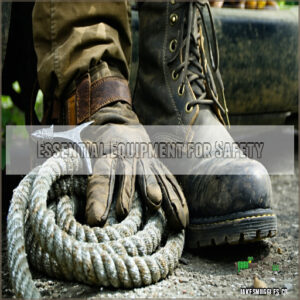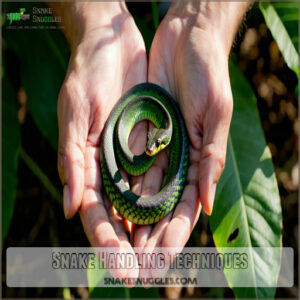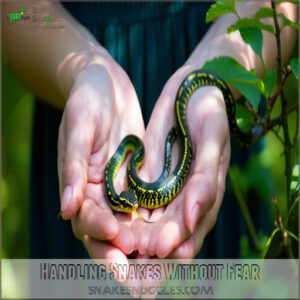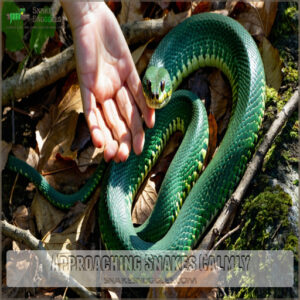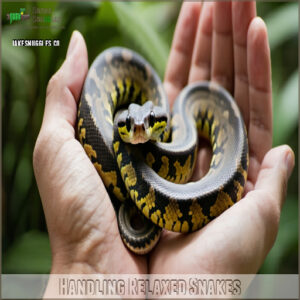This site is supported by our readers. We may earn a commission, at no cost to you, if you purchase through links.
 You’ll find it’s easier to handle a snake without fear when you’re properly equipped and informed.
You’ll find it’s easier to handle a snake without fear when you’re properly equipped and informed.
Start with the right tools: a sturdy snake hook and protective gloves are your best friends. Move slowly and deliberately, like you’re trying not to wake a sleeping baby.
Support the snake’s body gently – they’re not as scary when you realize they’re just as nervous as you are. Watch for signs of stress like rapid tongue flicking or defensive coiling, and always maintain a calm environment.
With practice, you’ll discover these fascinating creatures aren’t the spine-chilling monsters Hollywood makes them out to be, and handling them becomes easier when you’re properly equipped.
Table Of Contents
- Key Takeaways
- Handling Snakes Safely
- Handling Snakes Without Fear
- Approaching Snakes Calmly
- Holding Snakes Confidently
- Overcoming Ophidiophobia
- Frequently Asked Questions (FAQs)
- How do you handle a snake without stressing it?
- How to manage stress in snakes?
- Is it safe to approach a snake?
- How do you handle a snake for a beginner?
- Can you handle a snake with too much confidence?
- How to handle venomous snakes safely?
- Could you handle ALL snakes even if you follow these rules?
- What do you do when a snake poops? Do you clean it right away?
- Can someone handle a viper?
- How to get over fear of holding a snake?
- Conclusion
Key Takeaways
- Use proper equipment like snake hooks and gloves to handle snakes safely and reduce stress for both you and the snake.
- Move slowly and calmly to avoid triggering defensive behavior like coiling or hissing.
- Support the snake’s body evenly with both hands to help it feel secure and avoid grabbing its head or tail.
- Learn to read the snake’s body language, such as rapid tongue flicking or flattening, as these indicate stress or discomfort.
Handling Snakes Safely
You’ll find that handling snakes safely isn’t as scary as you might think, especially when you’re equipped with the right tools and knowledge.
Whether you’re a curious beginner or an aspiring herpetologist, proper handling techniques and a calm approach will help you build confidence while keeping both you and your scaly friend comfortable, which is key to a calm approach.
Essential Equipment for Safety
Before handling any snake, you’ll need the right equipment to stay safe.
Start with a sturdy snake hook – it’s your best friend for keeping a safe distance. Don’t forget puncture-resistant safety gloves and protective boots that cover your ankles.
Keep secure containers and snake restraint bags handy for transport. A detailed snake handling safety equipment list is essential for responsible handling.
Snake Handling Techniques
With your safety gear ready, let’s explore proper snake handling techniques. Start by gently using snake hooks or tongs to lift the snake, then shift to supporting its midbody with both hands.
Never grab the head or tail. It’s essential to maintain a steady grip while allowing natural movement, as this helps the snake feel secure.
Remember, even non-venomous species deserve respect – most snakes just want to feel secure during handling. It’s also crucial to review safe handling practices before interacting with a snake, to ensure a safe and positive experience for both you and the snake.
Recognizing Snake Stress Symptoms
Every snake shows clear stress signs through its body language.
You’ll notice rapid tongue flicking, defensive coiling, or aggressive hissing when your snake feels threatened.
Watch for changes in behavior like hiding or loss of appetite, which indicate discomfort.
If you spot muscle tremors or skin discoloration, give your snake space.
Remember, calm snake handling starts with recognizing these fear responses.
Handling Snakes Without Fear
Moving past your fear of snakes starts with understanding their behavior and respecting their space.
You’ll discover that these fascinating creatures aren’t the scary monsters movies make them out to be.
Proper snake handling preparation is essential for safety.
Through proper fear management techniques and safe handling practices, you can build confidence around snakes.
Here’s what experienced handlers recommend:
- Start with non-venomous species that are known for their docile temperament
- Practice handling techniques with a rubber snake until movements feel natural
- Learn to read snake body language to understand when they’re calm or stressed
- Work with a mentor who can guide your progress and make sure safety
Remember, overcoming snake phobia is a gradual process.
Take small steps, celebrate your progress, and don’t rush the journey.
With patience and proper snake safety knowledge, you’ll develop the skills needed to handle snakes confidently and safely.
Approaching Snakes Calmly
You’ll find that approaching a snake calmly starts with reading its body language and maintaining steady, gentle movements from the side.
When you’re confident and relaxed, your snake will sense your calm energy and be more likely to trust your handling, as this approach helps in creating a trusting environment for gentle interactions.
Building Trust With Snakes
Once you’ve managed your snake fears, it’s time to build a bond.
Start by understanding your snake’s sensitivity to vibrations and natural instincts.
Place your hand calmly in their enclosure for a few minutes daily, letting them get used to your presence.
When they show comfort through relaxed body language, you’re ready to begin gentle handling exercises, remembering that trust goes both ways, and it’s a matter of mutual understanding.
Maintaining a Quiet Environment
Building trust with your snake grows stronger in a quiet setting. You’ll want to create a calm environment that feels like a snake sanctuary, where your scaly friend can relax without startling sounds or vibrations.
Consider creating a snake-friendly backyard environment to foster a sense of security. Turn off loud music and TV noise that might spook your snake. Close windows to muffle outdoor sounds.
Keep other pets in separate rooms. Silence your phone notifications. Use soft, natural lighting instead of harsh fluorescents.
These snake calming techniques help create the peaceful interaction you’re looking for. When your environment stays quiet and controlled, your snake will feel more secure during handling sessions.
Avoiding Sudden Movements
A quiet snake is a happy snake, and your movements play a key role in keeping them calm.
When you approach a snake, think of yourself as moving through honey – slow, deliberate, and smooth.
Here’s what your movements tell a snake:
| Movement Type | Snake’s Response | Your Action | Safety Level |
|---|---|---|---|
| Quick, jerky | Defensive coiling | Step back, reset | High risk |
| Sudden reach | Strike warning | Pause, wait | Medium risk |
| Smooth, fluid | Relaxed posture | Continue gently | Low risk |
| Steady pace | Curious observation | Maintain rhythm | Safe |
Remember, steady movements show confidence, while sudden gestures might startle your scaly friend, and it’s essential to maintain a smooth, fluid approach to ensure a low risk interaction.
Recognizing Defensive Signals
A snake’s defensive signals are like traffic lights for your safety.
When you notice coiling, flattening, or rapid tongue flicking, your snake is telling you to back off.
Watch carefully for these warning signs that indicate stress:
- Head jerking and quick strikes mean the snake feels threatened
- Hissing and tail rattling are clear "stay away" messages
- Body flattening shows the snake is preparing to defend itself
Holding Snakes Confidently
You’ll feel more at ease handling snakes when you master the right support techniques, much like learning to carry a delicate glass vase.
Once you’ve got the basics down, you can confidently support a snake’s body with both hands while maintaining gentle, steady movements that keep both you and your scaly friend comfortable.
Supporting The Snake’s Body
How do you safely support a snake’s body? Start by positioning your hands for ideal weight distribution – one near the front third and another at the midbody.
Your grip should be firm but gentle, like holding a delicate glass. Let the snake’s body rest naturally across your palms, maintaining proper body support throughout.
Remember, consistent midbody support keeps both you and your serpentine friend secure, and it is crucial for safe handling.
Using Gentle Touch Techniques
Like a delicate flower, your touch should be gentle yet purposeful when handling snakes.
Start with a light touch at the snake’s mid-section, using your palm to provide steady support. You’ll want to maintain a gentle grip that’s firm enough to prevent escape but soft enough to avoid causing stress.
Keep your hands relaxed but ready, letting the snake feel secure without feeling restricted. This approach will help ensure a safe and successful handling experience, allowing you to interact with the snake in a purposeful manner.
Maintaining Slow Movements
Through slow handling, you’ll build confidence and keep your snake at ease.
When moving your hands, imagine you’re conducting an orchestra in slow motion – every movement should be deliberate and smooth. Your calm approach helps prevent startling the snake, while a steady grip maintains control.
Using proper handling techniques maintains safety and minimizes stress for both handler and snake.
Keep your movements fluid and unhurried, like you’re practicing tai chi with your reptilian friend, ensuring a smooth and stress-free interaction.
Handling Relaxed Snakes
Now that you’ve mastered slow movements, let’s focus on working with relaxed snakes. You’ll know your snake is calm when it shows smooth, unhurried movements and gentle tongue flicks.
Hold the snake with a gentle touch, supporting its body evenly. Create a calm environment by keeping noise levels low and avoiding quick gestures.
Remember, a relaxed handler means a relaxed snake.
Overcoming Ophidiophobia
You’re not alone if you find yourself freezing up at the sight of a snake, as this common fear affects millions of people worldwide.
Through proven methods like gradual exposure and professional guidance, you’ll learn to transform your fear into fascination while developing the confidence to handle these remarkable creatures safely, which can lead to a new sense of confidence.
Cognitive Behavioural Therapy
Many people find that Cognitive Behavioural Therapy helps them overcome their fear of snakes.
During therapy sessions, you’ll work with a professional to identify and challenge negative thoughts about snakes.
Your therapist will guide you through relaxation techniques and help you develop positive, realistic beliefs.
With mindful approaches and consistent practice, you’ll learn to manage your fear through behavioral changes and build confidence around snakes, leading to a more positive outcome through consistent practice.
Gradual Exposure to Snakes
How can you overcome your fear of snakes through gradual exposure? Start with educational videos and photos, then progress to observing snakes through secure enclosures.
Safe and proper reptile handling equipment is essential for interacting with snakes. This proven approach helps reduce anxiety naturally.
To begin the process, follow these steps:
- Watch snake documentaries for 15 minutes daily
- View photos of non-venomous species before bedtime
- Visit reptile exhibits weekly, staying 5 minutes longer each time
- Observe feeding times through glass enclosures
- Practice handling snake hooks while watching expert demonstrations to learn proper handling techniques.
Mindfulness and Relaxation Techniques
Through mindful awareness, you’ll discover powerful techniques to maintain a calm demeanor around snakes.
Consider exploring ophidiophobia mindfulness products to enhance your practice.
By practicing deep breathing and meditation, you can develop a relaxation response that helps overcome snake fear.
Here’s a practical guide to stress-free snake handling:
| Technique | Benefits | Practice Time |
|---|---|---|
| Deep Breathing | Reduces anxiety | 5-10 minutes |
| Meditation | Builds confidence | 15-20 minutes |
| Visualization | Mental preparation | 10-15 minutes |
| Body Scanning | Physical relaxation | 8-12 minutes |
Creating calm environments helps reduce snake stress and your own tension.
Remember to focus on your breath whenever you feel anxious.
Learning About Snake Behaviour and Biology
Understanding snake behavior starts with learning their unique sensory world.
You’ll discover that snakes don’t have eyelids but use special scales to protect their eyes.
Their forked tongues collect scent particles, helping them navigate their habitat.
By studying snake body language, like tail positioning and scale structure, you’ll recognize when they’re calm or stressed.
This knowledge builds confidence and reduces fear naturally.
Frequently Asked Questions (FAQs)
How do you handle a snake without stressing it?
Slow and steady wins the race—approach the snake calmly, avoiding sudden moves.
Hold it gently at mid-body with both hands for support.
Respect its space, observe its behavior, and always prioritize its comfort and safety.
How to manage stress in snakes?
To manage a snake’s stress, handle it gently and support its body evenly.
Approach calmly, avoid sudden movements, and limit handling time.
Make sure its enclosure has proper temperature, humidity, and hiding spots for comfort, ensuring the snake’s overall well-being is maintained with proper temperature.
Is it safe to approach a snake?
Approaching a snake is like meeting a shy neighbor—move slowly and keep your distance.
Watch for defensive cues like hissing or coiling.
Stay calm, approach from the side, and never make sudden movements.
How do you handle a snake for a beginner?
Start by using both hands to support the snake’s middle, letting it feel secure.
Move calmly, avoid squeezing, and never grab its head or tail.
Keep sessions short, and remember, practice makes perfect!
Can you handle a snake with too much confidence?
You can overdo confidence when handling a snake.
Acting too boldly might make you careless, missing subtle warning signs.
Stay calm, focused, and respectful, as confidence is fine, but overconfidence risks your safety and the snake’s well-being.
How to handle venomous snakes safely?
Handling venomous snakes is like defusing a live bomb—precision and care are non-negotiable.
Use snake hooks, wear protective gear, maintain distance, and never handle without proper training.
Prioritize safety, not bravery—it’s a life-saver.
Could you handle ALL snakes even if you follow these rules?
Not all snakes are safe to handle, even if you follow every rule.
Certain species, like venomous or aggressive ones, require professional expertise and specialized tools.
Always prioritize safety and know your limits with each snake.
What do you do when a snake poops? Do you clean it right away?
When a snake poops, clean it up promptly using gloves and a paper towel to avoid odors and bacteria.
Sanitize the area with reptile-safe cleaner, ensuring the enclosure stays fresh and hygienic for the snake.
Can someone handle a viper?
It’s no coincidence vipers require expert handling due to their venom.
Unless you’re trained, don’t attempt it.
Professionals use tools like hooks or tongs for safety. Respect their power and avoid risky encounters without preparation.
How to get over fear of holding a snake?
To overcome fear of holding a snake, start small by observing calm species from a distance.
Learn their behavior, approach slowly, and use gentle movements.
Gradually handle with expert supervision, building confidence step by step.
Conclusion
Taming your fear of snakes might feel like scaling a mountain, but it’s all about the right mindset and preparation.
Start with proper tools, stay calm, and move slow. Read the snake’s body language, support it gently, and avoid sudden movements.
Practicing these steps helps you learn how to handle a snake without fear. Over time, you’ll see they’re just fascinating creatures, not monsters.
Handling snakes confidently takes patience, but it’s a skill worth mastering.

